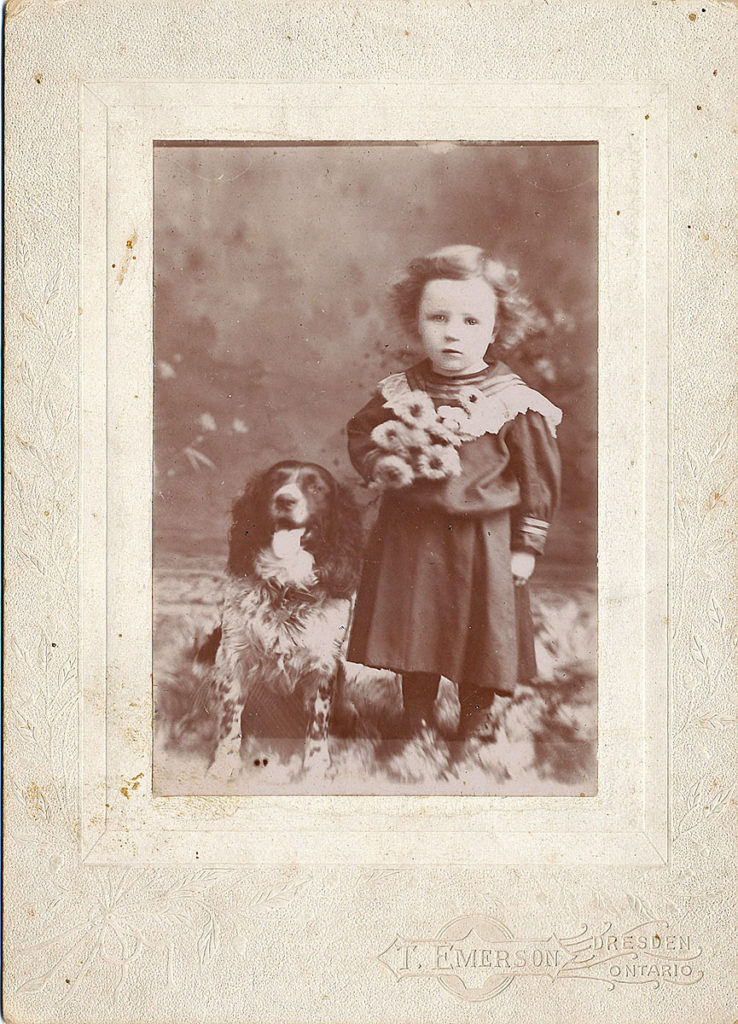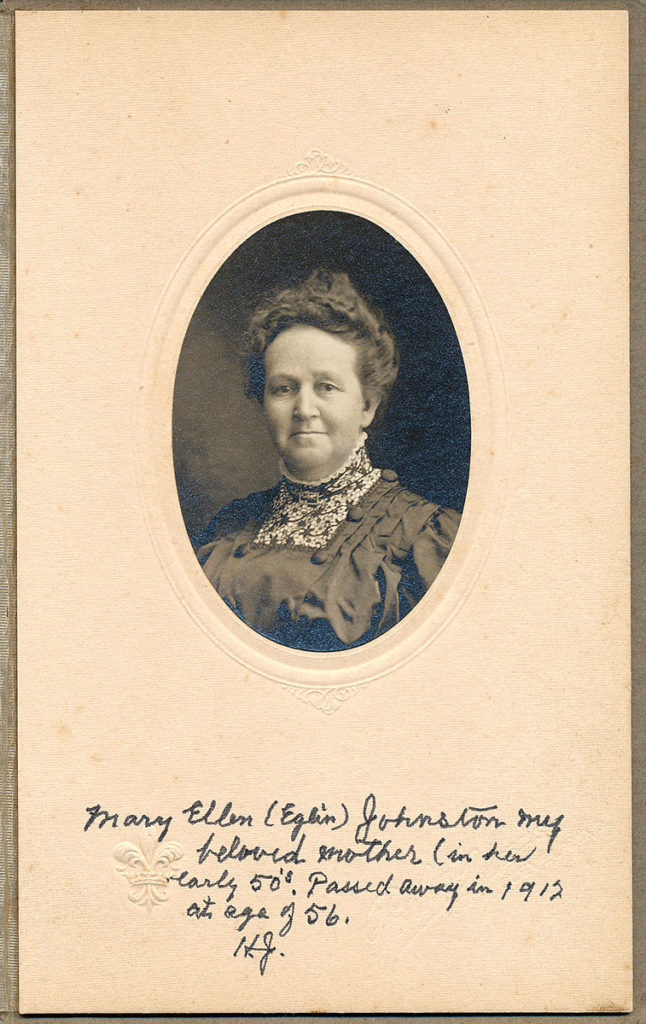
Homesteading His Way to College
Our maternal great grandmother, Mary Ellen (Eglin) Johnston, had high aspirations for her youngest son, Harold, who was our grandfather. It is interesting to me that she didn’t assume Harold would become a farmer or rancher, like his father, William, and his two older brothers. Nor did she expect him to follow in her father’s and brothers’ footsteps and become a tanner or leather craftsman. Instead, she hoped that he would go to college to become either a minister or a physician.
The specific professions she focused on likely reflect the fact that her brother, Thomas C. Eglin, was an Anglican minister; and her husband’s nephew, Will Webster, was an ear, nose, and throat doctor. She seems to have been confident that such goals were within young Harold’s reach.

Mary Ellen was about 38 when Harold was born in 1894. The next oldest child was his sister, Ethel, who was close to 11. His two brothers, Byron and Roy, were 20 and 15, respectively; and his eldest sister, Maud, was 18. So Harold was somewhat like an only child until his sister Helen Adeline was born seven years later in 1901.

Early in his schooling, Harold showed an aptitude for learning the academic basics of those times: reading, writing, grammar, mathematics; and sometimes science, history, languages, or other subjects. He was fortunate that his first teacher, Mr. Brandon, was good at his job. He taught grades one through eight in the one-room rural school north of the town of Dresden, Ontario, where the family lived. Writing his memoirs 77 years later at age 87, Harold credits Mr. Brandon for his achievement, describing him as “a young Englishman [who was] a wonderful teacher and person”. Clearly, Mr. Brandon made a lasting impression on Harold.
Thomas Harold Edward Johnston, about two years old, with his Grandmother Ellen Eglin’s dog “Dandy”
Harold was just three months shy of ten years old when he entered high school in the town of Dresden. He was two to five years younger than any of his classmates. Adjusting to high school was made even tougher, Harold says in his memoirs, because “I was a little runt, even for my age”.
Unfortunately, none of the high school’s three teachers challenged or mentored Harold in the same way Mr. Brandon had. Without that support, Grandpa later reflected, he “had probably become a pretty lazy student” in high school. Nevertheless, by age 16 he had completed grades 10 and 11, and received his “junior matriculation”. Although there were no teachers for grades 11 and 12, he had also earned his “senior matriculation” through independent study overseen by the principal. In those days, this qualified him to take the entrance exams for college. He confesses in his memoir, however, that he didn’t pass Latin.
In addition to her instincts about Harold’s academic abilities, I’d guess Mary Ellen’s hopes for his future reflected an awareness of the changing economic and social realities of the times. During the years Harold spent in high school, Canada was working its way out of a long economic recession. Along with that recovery, an increasing percentage of people across Canada were working for wages in industry and commerce rather than in farming or ranching. So, increasing numbers of workers were moving from rural areas to cities. Canada census data for 1891 showed that a little over half of the country’s working people made their living that year in non-farming occupations.

An article from The Canadian Encyclopedia* provides other interesting points about social and economic changes during those times. It was surprising to me that, in response to employment trends, as early as the mid-1800s — 170 years ago — parents in English Canada were using contraception to limit the size of their families. Fewer children meant that each child would have a better quality of life, including more and better education.
In spite of Mary Ellen’s efforts, raising funds for Harold’s tuition turned out to be impossible. Perhaps as a result of the long economic downturn, the family just didn’t have any money to spare.
Luckily, Harold’s brother, Roy, then about 30, came up with a proposal for raising the money. He offered to pay Harold $2,000 to work a “quarter section” (about 160 acres) of homestead land in southern Saskatchewan that adjoined his own homestead land. At that time, the government required that homesteaders pay a $10 registration fee (about $330 in today’s money); live on their land for three years, and cultivate and plant crops on a specified, increasing number of acres each year. Meeting those requirements, or “proving up” the land, earned homesteaders the “patent”, or deed, to their acreage.
After much deliberation, and with no other options in sight for raising Harold’s college tuition, Mary Ellen finally agreed to let her youngest son head west to work for and with his brother. Grandpa notes in his memoirs that he knew it was “a painful decision for her”, because of “her aspirations for my future”.
And so it was that, in March of 1911, Harold boarded a train headed for Toronto, his first stop on his way to Mortlach, Saskatchewan, where Roy would pick him up with a horse and wagon. His parents, I assume, provided Harold a “stake” of $50 to cover all expenses for the journey, including his homesteading fee, and new clothes appropriate for the rugged living conditions awaiting him. He stayed with the family of one of his mother’s childhood friends. She took him shopping for clothes at Eaton’s and Hudson’s Bay Company department stores.

He was 17 years old and beginning a journey that would shape the rest of his life. Sadly, Mary Ellen would not live long enough to see his adult achievements. She and his sister Helen did visit Harold and Roy in Saskatchewan for a month during 1911, and Harold spent time with the family in Dresden during the winter of 1911. Mary Ellen died of heart failure shortly after that, in May of 1912.
*The Canadian Encyclopedia, s.v. “History of Education in Canada,” by Chad Gaffield, Accessed December 25, 2021, https://www.thecanadianencyclopedia.ca/en/article/history-of-education
Follow this link to a great article (with photos): The one-room schoolhouse , in the Kingston (Ontario) Whig Newspaper, by Gord Sly, published in 2015, about the one-room schoolhouse as an institution of our grandparents’ time.

5 responses to “”
Thank you, once again, for a very personal journey in the history of your family. These are fascinating!
Linda and Val, well done! Both the writing and the photos are so interesting.
Thank you so much for enlightening us even more about Grandpa’s early life and the challenges they faced.
In Facebook ( a credible source?) a post shared what a person who was born in 1900 would live through. At 14 WW I would start and last 4 years, then The Spanish Flu, The Great Depression, WW lI and then The Korean and Vietnam War. So much loss!
A life that needed to build resilience.
Hi, Donna — I think I saw that post. And our generation picks up during/after WWII. The U.S. has been involved in Korea,
Vietnam, Iraq, Ethiopia, Afghanistan etc., etc., since then. Plus Polio, SARS, AIDS, Trump, and now COVID. Plus the 2008 Great
Recession, and Climate Change.
Somehow, we manage to find pleasure in friends, family, and work; art, music, travel, etc.
Thank goodness. Hope you’re well.
Linda
Wonderful story. Loving Grandmas vision.